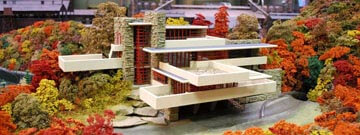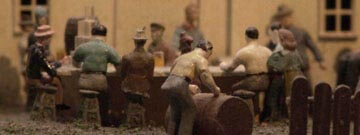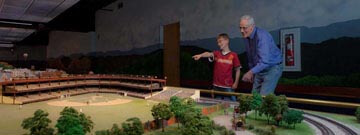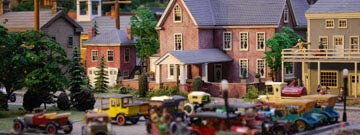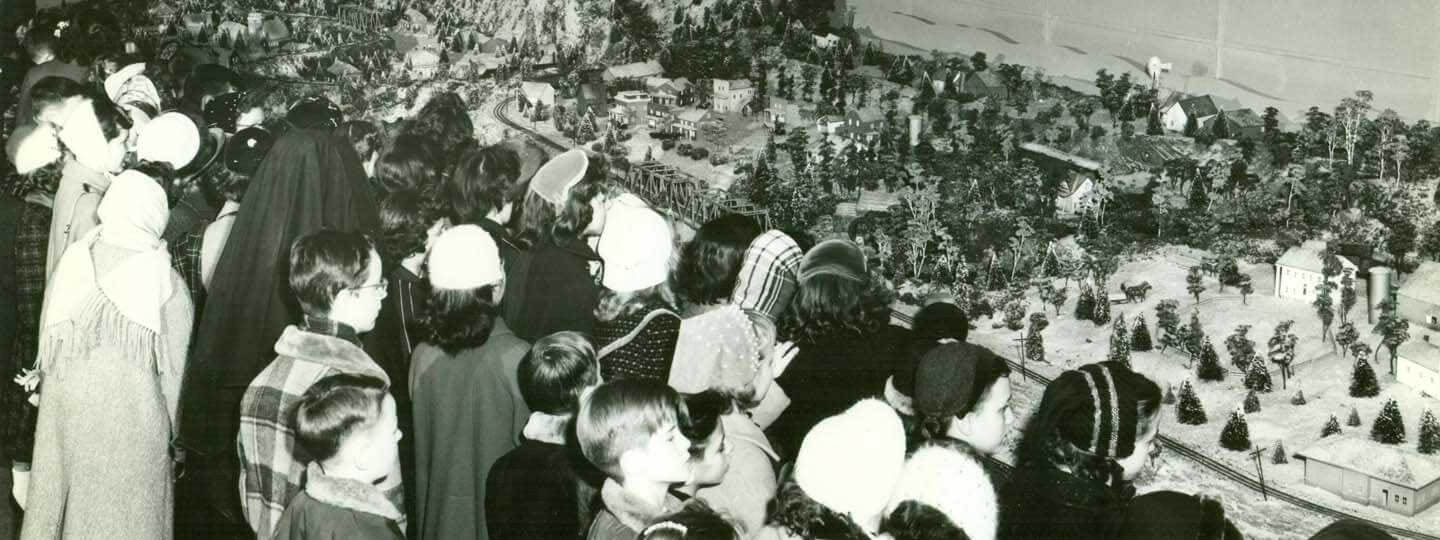
History
Since it was first displayed at the Buhl Planetarium in 1954, the Miniature Railroad & Village® has been an important Pittsburgh tradition. It all started at the brink of the Roaring ’20s with a man named Charles Bowdish of Brookville, Pa.
Charlie was the youngest son of Albert and Theodosia Bowdish. While serving in the army in WWI, he developed heart problems and received an honorable discharge. Afterward, he began building miniature railroad villages, the first holiday display beginning Christmas Eve 1919. It was an instant success! The years following, his display grew until it occupied most of the second floor of the Bowdish home.
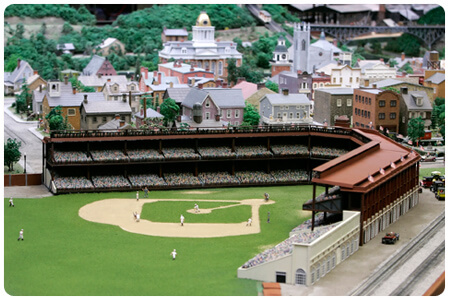 After several decades, Charlie began to think about moving his displays from Brookville. He made an agreement with the Buhl Planetarium, who wanted to adopt his masterpiece. Newly named the Christmastown Railroad, Charlie continued to take care of his miniatures and oversaw the construction. The first Christmastown Railroad was on display during most of the month of December 1954-nearly 24,000 visited!
After several decades, Charlie began to think about moving his displays from Brookville. He made an agreement with the Buhl Planetarium, who wanted to adopt his masterpiece. Newly named the Christmastown Railroad, Charlie continued to take care of his miniatures and oversaw the construction. The first Christmastown Railroad was on display during most of the month of December 1954-nearly 24,000 visited!
After a redesign and reconstruction, a greatly enhanced and enlarged Miniature Railroad & Village® debuted at Carnegie Science Center in 1992. The new permanent exhibit was 60% larger, and had nearly 100 animations and more than 250,000 miniature trees.
Following the tradition of Mr. Bowdish, each scale-model replica continued to be made with extraordinary attention to detail. The exhibit began to take on a historical and educational significance, with new additions like the Sharon Steel Mill and coke ovens. Each year a new replica has appeared on the large platform, reflecting a portion of western Pennsylvania history for all to enjoy.
The Miniature Railroad & Village® of today illustrates the Pittsburgh region’s rich and diverse history up until 1940. It was a time of dramatic changes, when Pittsburgh was called the workplace of the world. Its historical significance, captivating nature, and unprecedented artistry assure that it will remain a Pittsburgh treasure for years to come.
100 years of engineering memories
Contributions to the Miniature Railroad & Village® 100th Anniversary Campaign enabled the Science Center to refresh the gallery with new carpeting, fresh paint, historic photo montage, updated signage, and caboose camera allowing guests to see themselves from a miniature train perspective.
Visitors now enjoy motion-activated digital text panels which feature monthly scavenger hunts and model spotlights. The text panels keep the Miniature Railroad fresh and encourage visitors to spot something new each visit.
Now you can purchase a limited-edition commemorative book that highlights the history of the Miniature Railroad and the iconic models displayed in it. The book is co-authored by Robert Gangewere, a published author, and Patty Everly, former Curator of Historic Exhibits at Carnegie Science Center, who has stewarded the growth of the exhibition for more than 20 years. Titled A Love Story: The Miniature Railroad & Village, a portion of the proceeds from the book go toward sustaining the Miniature Railroad.
The Miniature Railroad & Village® Centennial Celebration is sponsored by:

History
Since it was first displayed at the Buhl Planetarium in 1954, the Miniature Railroad & Village® has been an important Pittsburgh tradition. It all started at the brink of the Roaring ’20s with a man named Charles Bowdish of Brookville, Pa.
Charlie was the youngest son of Albert and Theodosia Bowdish. While serving in the army in WWI, he developed heart problems and received an honorable discharge. Afterward, he began building miniature railroad villages, the first holiday display beginning Christmas Eve 1919. It was an instant success! The years following, his display grew until it occupied most of the second floor of the Bowdish home.
 After several decades, Charlie began to think about moving his displays from Brookville. He made an agreement with the Buhl Planetarium, who wanted to adopt his masterpiece. Newly named the Christmastown Railroad, Charlie continued to take care of his miniatures and oversaw the construction. The first Christmastown Railroad was on display during most of the month of December 1954-nearly 24,000 visited!
After several decades, Charlie began to think about moving his displays from Brookville. He made an agreement with the Buhl Planetarium, who wanted to adopt his masterpiece. Newly named the Christmastown Railroad, Charlie continued to take care of his miniatures and oversaw the construction. The first Christmastown Railroad was on display during most of the month of December 1954-nearly 24,000 visited!
After a redesign and reconstruction, a greatly enhanced and enlarged Miniature Railroad & Village® debuted at Carnegie Science Center in 1992. The new permanent exhibit was 60% larger, and had nearly 100 animations and more than 250,000 miniature trees.
Following the tradition of Mr. Bowdish, each scale-model replica continued to be made with extraordinary attention to detail. The exhibit began to take on a historical and educational significance, with new additions like the Sharon Steel Mill and coke ovens. Each year a new replica has appeared on the large platform, reflecting a portion of western Pennsylvania history for all to enjoy.
The Miniature Railroad & Village® of today illustrates the Pittsburgh region’s rich and diverse history up until 1940. It was a time of dramatic changes, when Pittsburgh was called the workplace of the world. Its historical significance, captivating nature, and unprecedented artistry assure that it will remain a Pittsburgh treasure for years to come.




